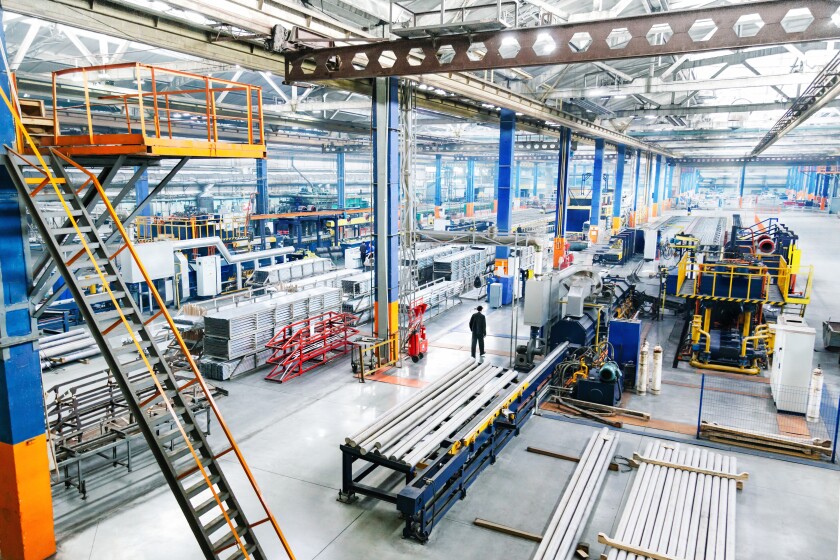In Brief:
- Despite the recent market meltdown, President Trump and his administration are counseling patience, arguing that over time his tariff strategy will bring about a rebound in domestic manufacturing.
- Some share of Trump’s political capital derives from his promises to bring jobs back from overseas in key industries. Since the pandemic, there’s been a broader interest in reshoring or nearshoring parts of the supply chain.
- But manufacturing in the U.S. remains expensive, primarily due to high labor costs.
Several years ago, back when he was still in the Senate, Marco Rubio gave a speech calling for a pro-American industrial strategy. The driving purpose of our economic policy, Rubio argued, should be rebuilding U.S. manufacturing capacity. “Outsourcing jobs to China may be more efficient because it lowers labor costs and increases profits,” said Rubio, now the secretary of state. “But the good jobs we lose end up destroying families and communities.”
This is the strategy that President Donald Trump is now pursuing. No matter the reaction of the markets or economists, Trump argues that his wide-ranging tariff policy will ultimately revive American manufacturing — not only bringing back industrial jobs but protecting the nation from dangerous supply shocks of the kind seen during the pandemic.
Despite the heat that the administration is currently taking, Trump was never alone in promoting the idea that reviving American manufacturing was in the country’s geopolitical interests. It would be inconvenient if China shut off the flow of the dozens of parts that go into an iPhone, but potentially disastrous if it suddenly became impossible to make or maintain F-35 fighter jets. Or shut off U.S. access to medical supplies.
“The Chinese Communist Party has demonstrated a willingness to weaponize supply chains and access to materials,” says Scott Paul, president of the Alliance for American Manufacturing. (Paul, like other experts quoted in this article, was interviewed before Trump outlined the specifics of his tariff policy last week.)
Trump’s “America First” vision of viewing trade as a tool for boosting domestic production has had real political resonance since he formally entered politics a decade ago. About 1 in 5 American workers had manufacturing jobs at the end of the 1970s; now it’s more like 1 in 12. “Is it really worth sacrificing all those jobs so that the consumer can save a couple of percentage points on the cost of a product?” asks Nick Iacovella, executive vice president of the Coalition for a Prosperous America, a trade group of domestic producers. “Ten to 15 years ago, the answer would be yes, but today it’s a resounding no.”
That may be the case, but the effects of Trump’s tariffs — and the residual tariffs being imposed by other countries — not only panicked the markets but triggered serious warnings about recession and increased inflation. The stock market dramatically rebounded Wednesday when Trump announced a 90-day pause on some tariffs. The president and his advisers have been calling for patience, arguing that the longer-term gains in the domestic economy will be worth any short-term pain caused by market disruptions. Trump on Wednesday called on Americans not to panic but “be cool.”
But Trump’s desire to transform the American economy and its place in the world may still be the biggest bet of his political career. Already, there have been announcements from plants laying off workers, concerns about prices increasing on everyday essentials and warnings that the U.S. lacks both the workforce and industrial capacity to be able to revive manufacturing in any number of key sectors.
The fact that Trump called a pause, while it was welcomed, did not end the sense of uncertainty in corporate America. He continues to ratchet up the size of tariffs on China, almost on a daily basis.
“Whose throat do I get to choke if this proves to be wrong?” Thom Tillis, a Republican senator from North Carolina, asked U.S. Trade Representative Jamieson Greer during a hearing about the tariff strategy on Tuesday.

(Adobe Stock)
The $20 Blender Problem
There are two main reasons for the historic decline in U.S. manufacturing: automation and trade. Jobs that used to require brute force or at least a skilled pair of hands are now often performed by machines. Functions that do require human labor are often done overseas.
Thirty years ago, China produced 3 percent of the world’s manufacturing output. Now, it’s just under a third. Over the same period, the U.S. share has declined from 22 to 16 percent, leaving the country second in the world with roughly half the output of China. “When Trump came down the escalator in 2015 and said China’s ripping us off, that resonated so well politically because a whole bunch of voters saw the effect of these decisions,” Iacovella says.
Other recent administrations have attempted to reverse manufacturing’s fortunes. The Obama administration spent billions bailing out the auto industry, which still represents half of the U.S. manufacturing economy. During Joe Biden’s presidency, the federal government pumped something on the order of $1 trillion into manufacturing subsidies through the CHIPS and Science Act; the Inflation Reduction Act, which contained major tax credits for clean energy; and the 2021 infrastructure law.
Despite the big-deal announcements of $40 billion semiconductor plants and the like, however, manufacturing construction had stalled by the end of the Biden administration. For one thing, sometimes the actual investments got delayed or didn’t match the announcements.
But there also remained macroeconomic headwinds pushing back against domestic manufacturing, including the comparatively high cost of American labor and the lack of skilled workers. “If you are going to manufacture in a high-cost country like the U.S., what are you going to do to overcome that labor cost disadvantage?” says Willy Shih, a supply chain expert at Harvard Business School. “That $20 blender that you find at Walmart, that’s not coming back to the U.S.”
What Could Go Wrong
The things that make sense to manufacture in the U.S., Shih says, are items where labor costs are a relatively small part of the equation, or there’s intellectual property that’s worth protecting. Jet engines are a good example, he says.
There are cheaper items where labor costs are minimal — but that’s because manufacturing is now often highly automated. Manufacturing relies less on brute strength than on knowledge of science or math or computers. “The school systems are not preparing students with these kinds of basic skills to be able to be productive in the workforce,” says August Benzow, former research lead at the Economic Innovation Group, a public-policy organization. “The current administration doesn’t seem to have a proposal to really focus on that kind of upskilling.”
Maybe that will change, but the dismantling of the Department of Education is not a promising sign, nor are the president’s cuts to scientific research grants. And his immigration policies will also put pressure on the domestic workforce.
It’s possible that over time, the administration will roll out more policies to bolster manufacturing, perhaps even offering subsidies. But Trump has been a critic of such efforts. As soon as he took office, Trump ordered a freeze on spending under the Inflation Reduction Act and the infrastructure law.
As with many Trump spending cuts, that move has been held up in court. But Trump has also aimed his ire at the CHIPS and Science Act, which provides subsidies to advanced manufacturers. In his address to Congress last month, Trump called for that law’s repeal, calling it “a horrible, horrible thing.”
Companies that are building plants that won’t be operational for a number of years will want greater reassurance that any federal policies meant to help them will remain solidly in place.
The administration contends that global tariffs will essentially force manufacturers to move more of their operations to the U.S. in order to have access to such a rich market. Despite widespread desire for a domestic manufacturing renaissance, most economists are skeptical.
“Tariff threats are not costless,” says Scott Lincicome, vice president of economics and trade policy at the Cato Institute, a libertarian-leaning think tank. “Uncertainty depresses investment and hiring, because if you are going to be spending millions and millions of dollars on a new factory or new equipment, that might be put into peril or be a lot more expensive with tariffs or retaliation from foreign governments.”









